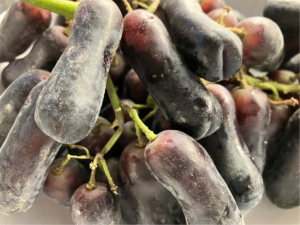Witch Fingers and Moon Drops

Today is Halloween, and yes, I have some Witch Fingers in my fridge. Well, technically, they’re Moon Drops. I’m talking about grapes, of course.
These spooky-themed table grapes have long, tubular, seedless berries with snappy skin and a flavor some compare to Welch’s grape concentrate. Their skins may be dark red (Witch Fingers, which taper to a pointy end), dark blue (Sweet Sapphire, a.k.a., Moon Drops, as they’re marketed by Grapery) or green (Tear Drops). The elongated shape was an innovation from University of Arkansas and further crosses at International Fruit Genetics led to Witch Fingers, a name trademarked by Grapery. To my mind, these were some of the first varieties that went beyond more utilitarian traits like yield, texture, sweetness, seedlessness and postharvest hardiness to push the boundaries of reality. I mean, grapes are round (more or less). Aren’t they?
As I was thinking about (and snacking on) these oblong oddities, a news item dropped into my inbox titled, “Could Salt Water Be the Solution to Future Irrigation Woes?” Recognizing the dwindling supply and declining quality of water, the article explains this existential issue for farmers. “You can’t water plants with salt water because it’s too dense; plants [can’t] absorb it through the soil. Instead, higher salt levels leech water out” and eventually kill them. However, scientists in Saudi Arabia have successfully integrated salinity tolerance from crop wild relatives into cherry tomato plants that can be watered with salt water, which the world has in abundance. The plants produce more sugar to counteract the higher levels of salt, so the super-sweet fruits are a commercial hit. Of course, these are greenhouse plants, grown hydroponically. Obviously, with a permanent crop like grape, open-field irrigation using salt water poses soil health and root zone issues. But the point is, scientists are bending the rules of plant biology to adapt to the reality of water scarcity.
None of these grape or tomato varieties were gene-edited or even genetically modified. The DNA of other species were not mixed in to create some crazy frankenfruit. To be sure, with their elongated shape and dimpled ends, Moon Drops could appear to be grapes from outer space. But no, they’re the product of traditional breeding.
Yet traditional breeding itself has changed. The understanding of gene expression and the identification and application of markers (regions of DNA) for traits of interest has improved and accelerated breeders’ ability to improve beloved varieties and make innovative new ones. Varieties that once took decades to develop now come to market in 10 to 12 years. Further discoveries in grape genomics will enable breeders to zero in on specific genes to work a kind of scientific magic. Faster, more precise breeding may help to head off to grim realities we can’t even fully anticipate or imagine.
Just think of grapes that are adapted to a chaotic climate and “born digital” vineyards that are adapted to mechanization and precision farming. Imagine viticulture free of pests and diseases, grapes that can do more with less. If we can transform table grapes into Witch Fingers, there’s no telling what we can do!
Donnell Brown
President